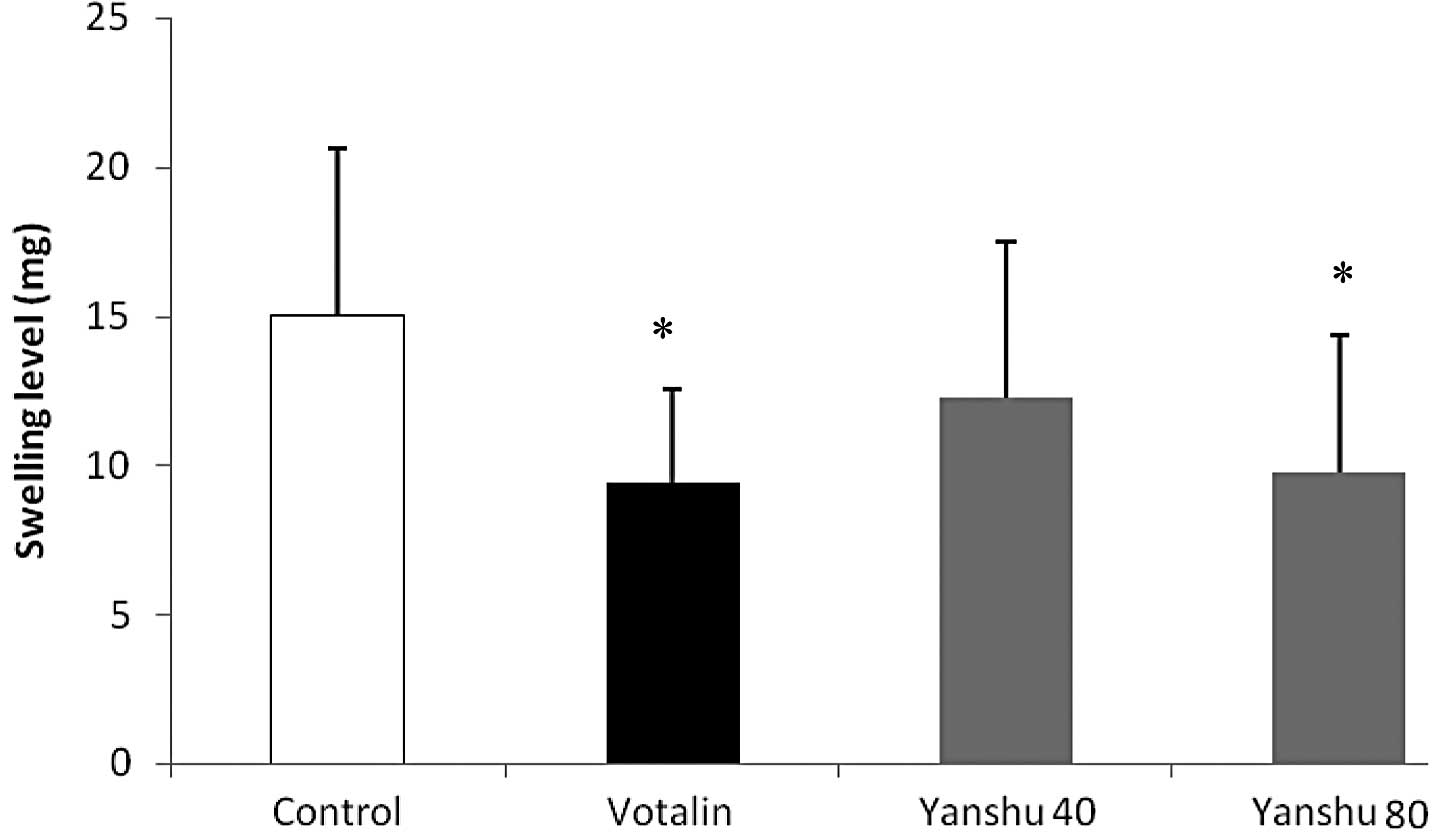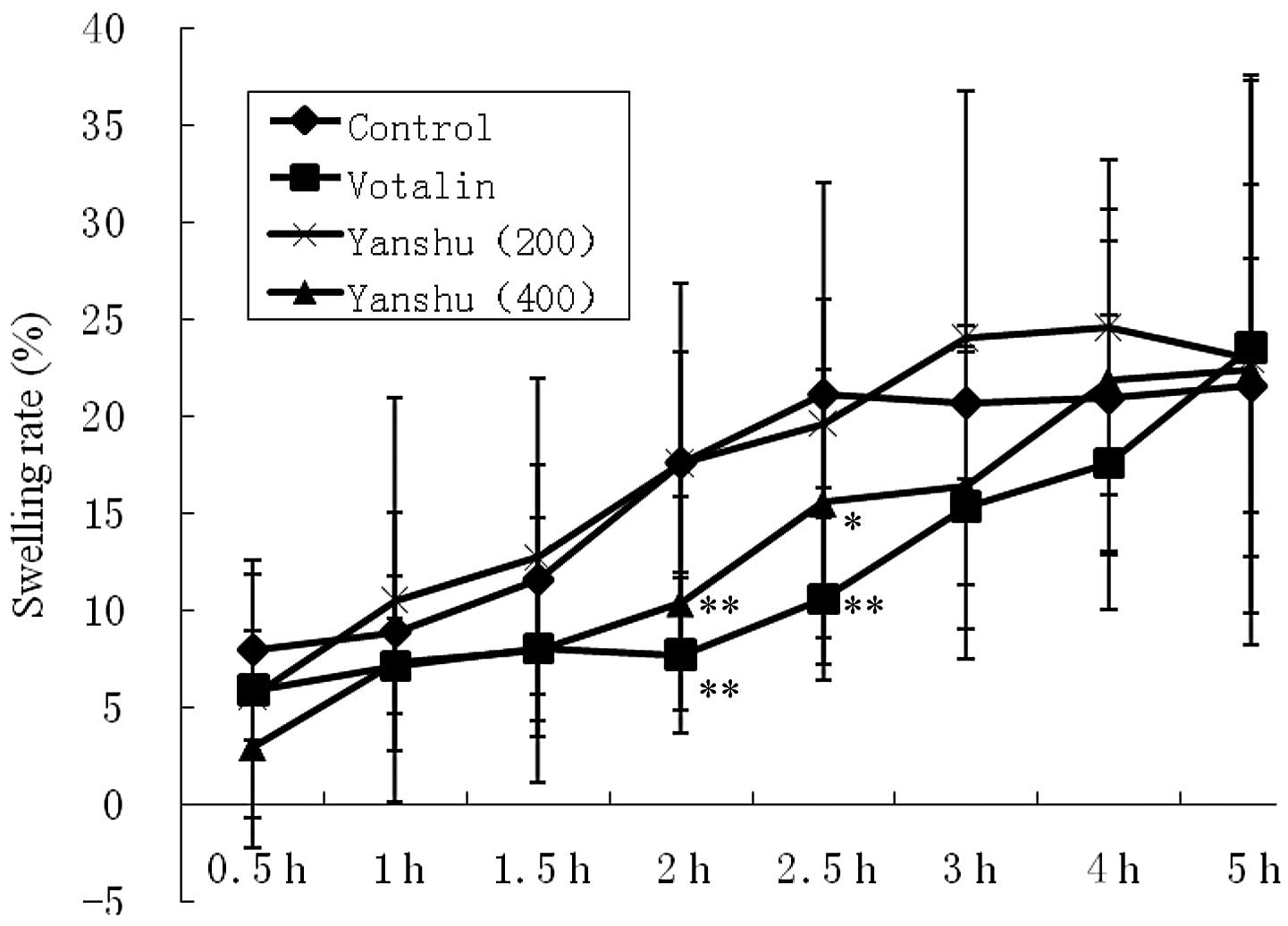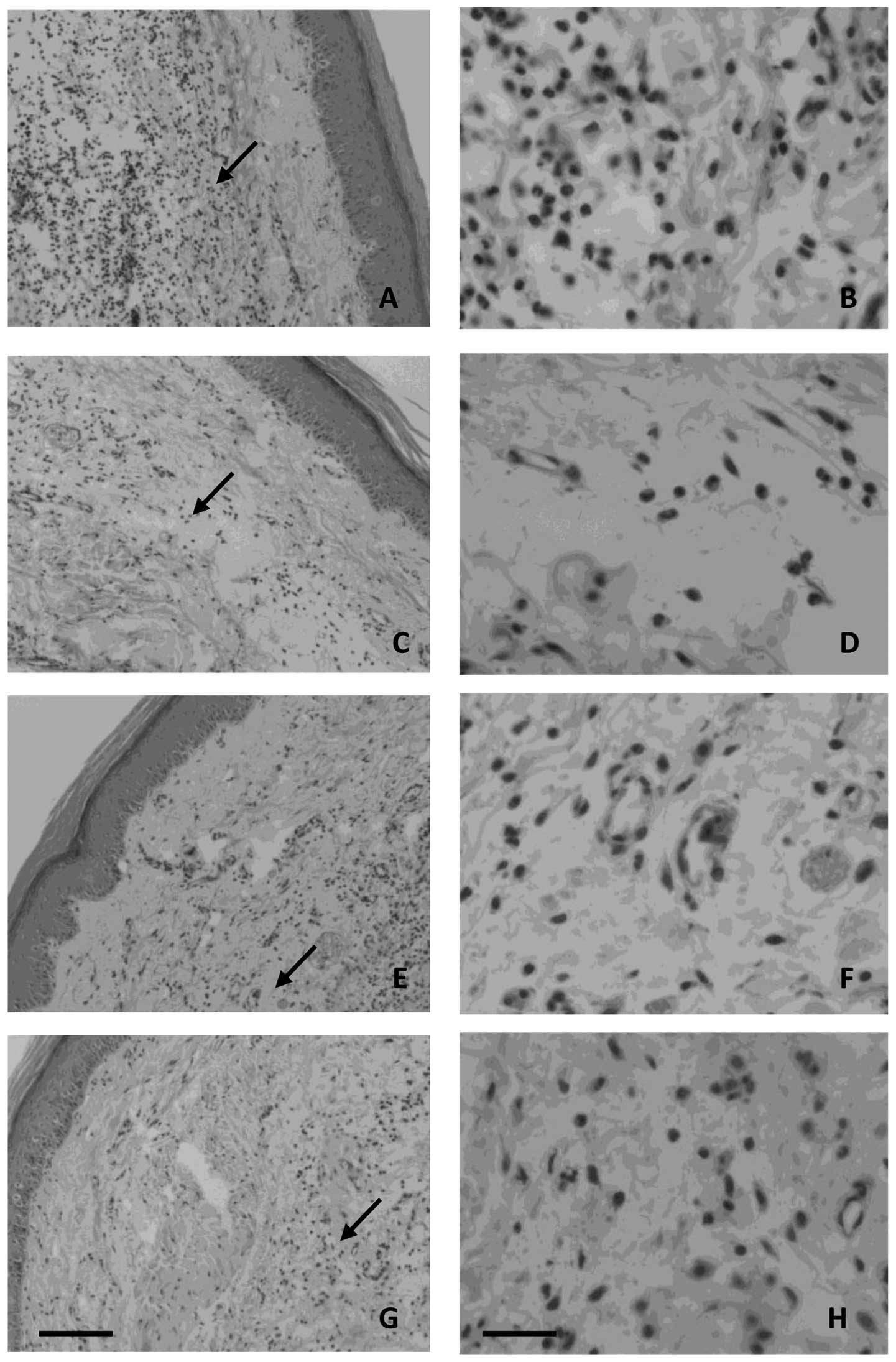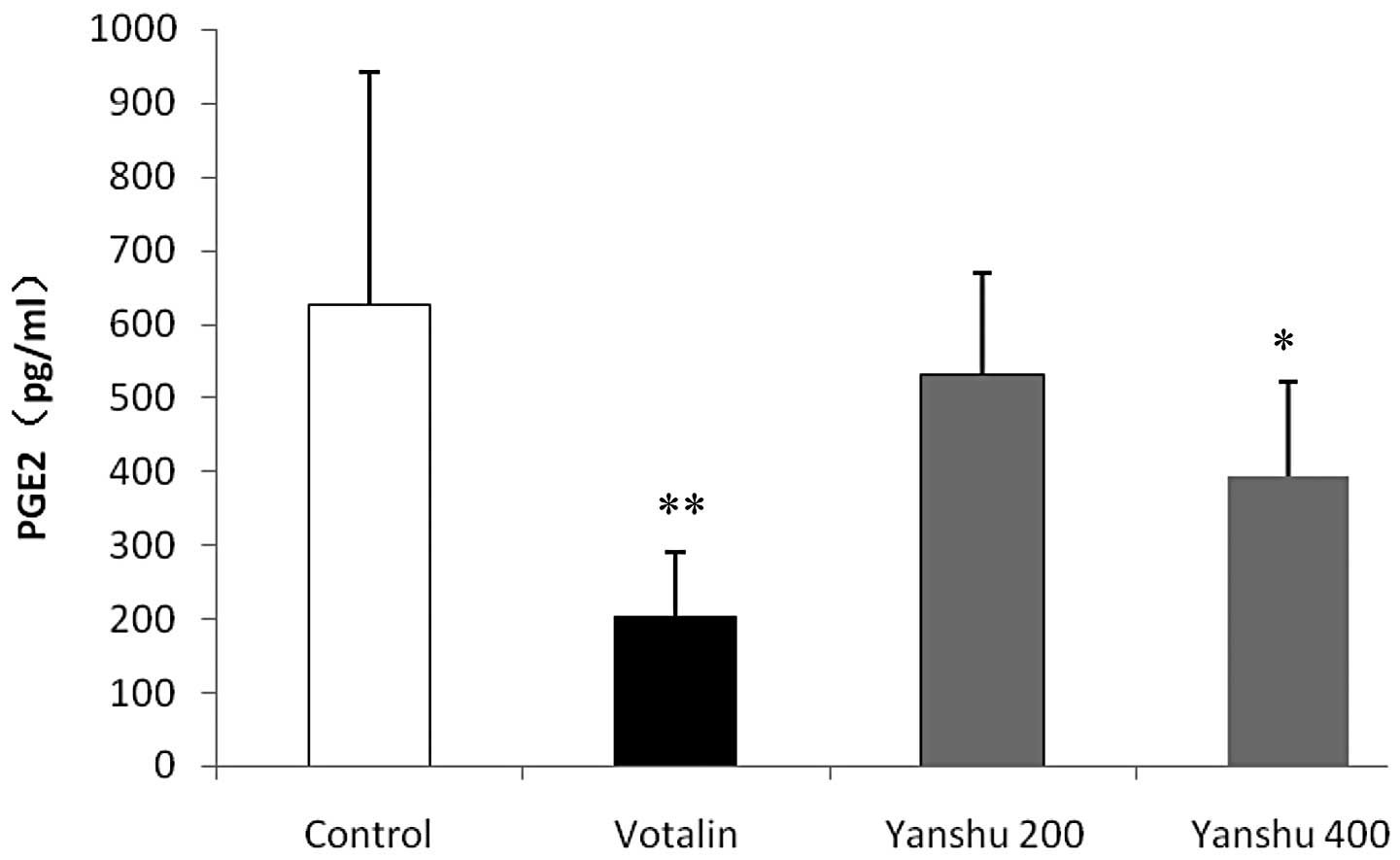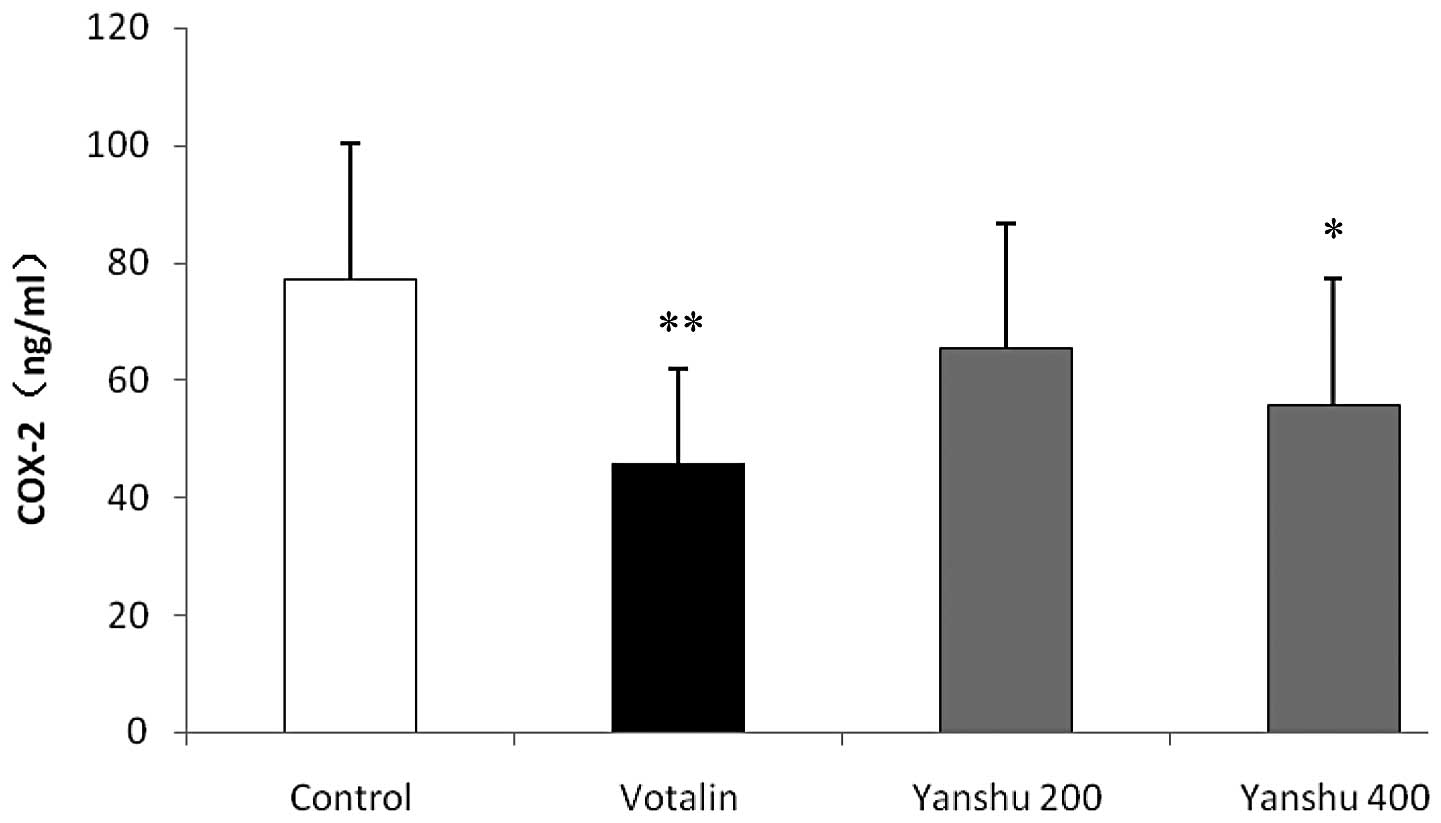Introduction
Acute pharyngitis, an acute inflammation of the
pharyngeal mucous membrane, is often caused by upper respiratory
tract infection with a virus or bacteria. Its clinical
manifestations include soreness of the throat, cough, pain on
swallowing and fever (1).
The most common causes of acute pharyngitis are
viral infections (2). Normally,
the illness is mild and self-limiting but it may worsen due to
bacterial superinfection, most commonly by group A or C β-hemolytic
streptococci. Serious sequelae, including rheumatic fever and
endocarditis, may follow bacterial superinfection (1). Due to the predominantly viral cause,
antibiotics have only a minor benefit upon the resolution of
pharyngitis symptoms. Thus, in most cases the treatment of acute
pharyngitis is symptomatic, focusing on the management of symptoms
such as fever, pain and inflammation.
Previous treatments of acute pharyngitis with fever,
pain or inflammation include non-steroidal anti-inflammatory drugs
and steroids (3,4), which have potential risks and
side-effects (5). Chinese
traditional medicine has been used to treat pharyngitis for a
number of years (6,7). The treatment principle for this
disease depends upon its symptoms or cause. Anti-inflammatory,
antiviral and fever relieving herbs are the basic elements of the
prescription.
Yanshu spraying agent, a potential drug for
pharyngitis, consists of eleven herbs, including Radix Sophorae
Tonkinensis, Calyx seu Fructus Physalis Francheti and
Radix Scutellariae Baicalensis. However, its pharmacological
effects have not been demonstrated. The aim of this study was to
investigate the anti-inflammatory effects of Yanshu in the
treatment of xylene- and carrageenan-induced acute inflammation in
animals.
Materials and methods
Drugs and chemicals
Yanshu was provided by Shandong Luye Pharmaceutical
Co., Ltd. (Yantai, China; batch no. 20110810). It is composed of 11
plant materials: Radix Sophorae Tonkinensis, Calyx seu
Fructus Physalis Francheti, Periostracum Cryptotympanae,
Radix Rehmanniae, Fructus Arctii, Radix
Scutellariae Baicalensis, Radix Paeoniae Rubra, Semen
Oroxyli, Semen Sterculiae Lychnophorae, Cortex Moutan
Radicis and Herba Menthae Haplocalycis in a ratio of
1.7:1.7:1.7:2.4:1.7:1.7:2:1.7:1.7:1.7:1.7 (by dry weight). All
plant materials were chosen according to the Pharmacopoeia of the
People’s Republic of China (2010). Yanshu (2 kg) was prepared as a
mixture of all the above components and extracted twice with
distilled water (24 and 20 l) at 100°C for 1.5 h. After filtering,
the liquid extract was concentrated with a rotary vacuum evaporator
to a concentration of 2.0 g/ml and stored at 4°C.
Diclofenac diethylamine emulsion (Votalin) was
purchased from Novartis Pharmaceutical Co. (Beijing, China; batch
no. X2347); prostaglandin E2 (PGE2) and cycloxygenase-2 (COX-2)
ELISA assay kits were purchased from Shanghai Xitang Biological
Technology Co., Ltd. (Shanghai, China; batch nos. 1206122 and
1204251); xylene was purchased from Tianda Chemical Factory
(Tianjin, China); and λ-carrageenan was purchased from
Sigma-Aldrich (Shanghai, China; batch no. 1408463V).
Animals
Mice weighing 18–22 g and male Wistar rats weighing
160–200 g were purchased from the Experimental Animal Center of
Shandong Luye Pharmaceutical Co., Ltd. All experimental procedures
carried out in this study were performed in accordance with the
guidelines for the care and use of laboratory animals of Yantai
University, and were approved by the Ethics Committee. All the
animals were housed in diurnal lighting conditions (12/12 h) and
allowed free access to food and water.
Xylene-induced ear edema model
Forty Swiss mice were randomly divided into control,
Votalin and two Yanshu groups (40 and 80 μl doses), each
containing 10 animals. Both ears of each mouse were smeared with
saline, 50 mg Votalin, 40 μl Yanshu (Yanshu 40) or 80
μl Yanshu (40 μl twice at intervals of 30 min; Yanshu
80). Xylene (20 μl) was dropped onto the anterior and
posterior surfaces of the right ear 30 min after the final
administration. The mice were sacrificed 1 h after the application
of xylene. An ear disc of 9.0-mm diameter was punched out of each
ear and weighed. The level of edema was determined from the weight
difference between the right (treated) and the left (control) ear
discs of the same animal. The inhibition level (%) was calculated
according to the following equation: Inhibition (%) = (1−Et/Ec) ×
100, where Et is the average edema of the treated group and Ec is
the average edema of the saline-treated control group.
Carrageenan-induced paw edema model
Forty Wistar rats were randomly divided into
control, Votalin, Yanshu 200 μl (100 μl twice at
intervals of 15 min; Yanshu 200) and Yanshu 400 μl (100
μl 4 times at intervals of 15 min; Yanshu 400) groups. The
right-hind paw of each rat was then smeared with saline, Votalin or
Yanshu. Carrageenan (0.1 ml, 1%w/v) was injected into the
right-hind paw (sub-plantar) 30 min after the final administration.
The paw volume was measured prior to the irritant injection and at
selected intervals (0.5, 1, 1.5, 2, 2.5, 3, 4 and 5 h) thereafter
with a hydro-plethysmometer (Shandong Academy of Medical Sciences,
Shandong, China). Results were expressed according to the increase
in paw volume (ml) calculated by subtracting the basal volume.
Hematoxylin and eosin (H&E)
staining
Three hours after carrageenan injection, the rats
were anesthetized with chloral hydrate and tissues of the
right-hind paw were excised and immersed into 4% formaldehyde for
24 h. The tissues were then embedded in paraffin, sectioned (5
μm) using a microtome and stained with H&E. The
pathological features were determined by analysis under a
microscope (magnification, x400; Olympus BX41, Tokyo, Japan).
PGE2 and COX-2 assay
Three hours after carrageenan injection, the rats
were anesthetized with chloral hydrate and tissues of the
right-hind paw were separated on ice and homogenized with ice-cold
saline to form a 10% (w/v) homogenate. The levels of PGE2 and COX-2
in the paw were determined using an ELISA kit.
Statistical analysis
The data are expressed as mean ± SD. Data was
analyzed using one-way ANOVA with Bonferroni post hoc test for
multiple t-tests. P<0.05 was considered to indicate a
statistically significant result.
Results
Effects of Yanshu on xylene-induced ear
edema in mice
The treatment of the mice with Yanshu 80 but not
Yanshu 40 suppressed xylene-induced ear edema significantly,
reducing swelling by 34.7% compared with the control group. Votalin
administration decreased swelling by 37.3% 1 h after the induction
of ear edema (Fig. 1).
Effects of Yanshu on carrageenan-induced
paw edema in rats
The treatment of rats with Yanshu 400 but not Yanshu
200 significantly inhibited the development of paw edema at 2 h
(P<0.01) and 2.5 h (P<0.05) after carrageenan injection.
Votalin also significantly decreased the carrageenan-induced paw
edema at 2 h (P<0.01) and 2.5 h (P<0.01) after carrageenan
injection (Fig. 2).
Effects of Yanshu on histological
pathology of the paws in rats
A large number of inflammatory cells were observed
in the paw tissue 3 h after carrageenan injection and the number of
neutrophils increased significantly (Fig. 3A and B). Compared with the control
group, Votalin and Yanshu treatment, particularly at the higher
dose, reduced the number of inflammatory cells significantly
(Fig. 3C, D, G and H).
Effects of Yanshu on the PGE2 levels of
the paws in rats
The PGE2 level increased significantly in the paw
tissue 3 h after carrageenan injection. Votalin and Yanshu 400
decreased the PGE2 level significantly 3 h after carrageenan
injection (P<0.01 and P<0.05, respectively; Fig. 4).
Effects of Yanshu on COX-2 level of the
paws in rats
The COX-2 level increased significantly in the paw
tissue 3 h after carrageenan injection. Votalin and Yanshu 400
decreased the COX-2 level significantly 3 h after carrageenan
injection (P<0.01 and P<0.05, respectively; Fig. 5).
Discussion
In the present study, we examined the in vivo
anti-inflammatory effect of Yanshu using two common animal models
of inflammation, xylene-induced ear edema in mice and
carrageenan-induced paw edema in rats. In addition, the
histopathology and inflammatory mediators, including PGE2 and
COX-2, were determined to illuminate the underlying
anti-inflammatory mechanisms of action.
Xylene-induced ear edema in mice is a simple animal
model for evaluating potential anti-inflammatory agents (8,9). In
our study, xylene-induced ear edema led to fluid accumulation and
edema, characteristic of the acute inflammatory response. Treatment
of the mice with Votalin and a high dose of Yanshu suppressed
xylene-induced ear edema, reducing swelling by 37.3 and 34.7%,
respectively. The data indicate that Yanshu possesses inhibitory
effects against acute inflammation.
Carrageenan-induced paw edema is another model which
is widely employed for screening the effects of anti-inflammatory
drugs (10,11). The acute inflammatory response
induced by carrageenan injection involves two phases (12). The early phase occurs during the
first hour of exposure and is associated with the release of
histamine, serotonin, bradykinin and, to a lesser extent,
prostaglandins (PGs). The delayed phase after one hour is
attributed to polymorphonuclear (PMN) leucocyte infiltration and
the continuation of PG generation. In the present study, a large
number of inflammatory cells were observed in the paw tissue 3 h
after carrageenan injection and the number of neutrophils increased
significantly. Compared with the control group, Votalin and Yanshu
treatment, particularly the higher dose, reduced the number of
inflammatory cells significantly. These data support the results
from the ear edema assay and verify the anti-inflammatory effect of
Yanshu against acute inflammation.
It is well established that PGs, by virtue of their
activity as modulators of inflammatory responses, have a major role
in the inflammatory process. COX is the key enzyme that synthesizes
PGs and thromboxane from arachidonic acid. Inappropriate COX-2
expression is known to be involved in the development of
inflammatory pathogenesis seen in diseases of the gastrointestinal
tract and central nervous system, ischemia and lung inflammation
and fibrosis (13,14). In the present study, treatment with
Yanshu significantly inhibited the paw edema 2–2.5 h after
carrageenan injection. In addition, Yanshu also decreased the
production of PGE2 and COX-2 in the hind paws of
carrageenan-treated rats; this indicated that Yanshu exerted an
anti-inflammatory effect by inhibiting the PGE2/COX-2 inflammatory
pathway.
In conclusion, the present study demonstrated that
Yanshu possesses anti-inflammatory activities that may be mediated
through the regulation of the PGE2/COX-2 inflammatory pathway.
These findings indicate that Yanshu may be of benefit for the
treatment of acute pharyngitis in the clinic.
Acknowledgements
This study was supported by the 11th
Five Years Key Programs for Science and Technology Development of
China (grant no. 2010ZX09102-207) and Taishan Scholar Project. The
authors are grateful to Professor Tongshen Liu for providing
technical assistance in pathological observation.
References
|
1
|
Bisno AL: Acute pharyngitis. N Engl J Med.
344:205–211. 2001. View Article : Google Scholar : PubMed/NCBI
|
|
2
|
Shah R, Bansal A and Singhi SC: Approach
to a child with sore throat. Indian J Pediatr. 78:1268–1272. 2011.
View Article : Google Scholar : PubMed/NCBI
|
|
3
|
Schams SC and Goldman RD: Steroids as
adjuvant treatment of sore throat in acute bacterial pharyngitis.
Can Fam Physician. 58:52–54. 2012.PubMed/NCBI
|
|
4
|
Tasar A, Yanturali S, Topacoglu H, Ersoy
G, Unverir P and Sarikaya S: Clinical efficacy of dexamethasone for
acute exudative pharyngitis. J Emerg Med. 35:363–367. 2008.
View Article : Google Scholar : PubMed/NCBI
|
|
5
|
Mullarkey C: Soothing a sore throat: the
efficacy and safety of steroids in acute pharyngitis. Ir J Med Sci.
180:837–840. 2011. View Article : Google Scholar : PubMed/NCBI
|
|
6
|
Huang Y, Wu T, Zeng L and Li S: Chinese
medicinal herbs for sore throat. Cochrane Database Syst Rev.
3:CD0048772012.
|
|
7
|
Sun Y, Zang Z, Xu X, Zhang Z, Zhong L, Zan
W, Zhao Y and Sun L: Experimental investigation of the
immunoregulatory and anti-inflammatory effects of the traditional
Chinese medicine ‘Li-Yan Zhi-Ke Granule’ for relieving chronic
pharyngitis in rats. Mol Biol Rep. 38:199–203. 2011.PubMed/NCBI
|
|
8
|
Zhang Z, Luo P, Li J, Yi T, Wang J, An J
and Zhang H: Comparison of the antiinflammatory activities of three
medicinal plants known as ‘meiduoluomi’ in Tibetan folk medicine.
Yakugaku Zasshi. 128:805–810. 2008.
|
|
9
|
Wang D, Wang S, Chen X, Xu X, Zhu J, Nie L
and Long X: Antitussive, expectorant and anti-inflammatory
activities of four alkaloids isolated from Bulbus of Fritillaria
wabuensis. J Ethnopharmacol. 139:189–193. 2012. View Article : Google Scholar : PubMed/NCBI
|
|
10
|
Li YC, Xian YF, Ip SP, et al:
Anti-inflammatory activity of patchouli alcohol isolated from
Pogostemonis Herba in animal models. Fitoterapia. 82:1295–1301.
2011. View Article : Google Scholar : PubMed/NCBI
|
|
11
|
Niu X, Xing W, Li W, Fan T, Hu H and Li Y:
Isofraxidin exhibited anti-inflammatory effects in vivo and
inhibited TNF-α production in LPS-induced mouse peritoneal
macrophages in vitro via the MAPK pathway. Int Immunopharmacol.
14:164–171. 2012.PubMed/NCBI
|
|
12
|
Gilligan JP, Lovato SJ, Erion MD and Jeng
AY: Modulation of carrageenan-induced hind paw edema by substance
P. Inflammation. 18:285–292. 1994. View Article : Google Scholar : PubMed/NCBI
|
|
13
|
Botting J: Defining the role of COX-2
inhibitors in inflammatory and other diseases. Drug News Perspect.
13:560–566. 2000. View Article : Google Scholar : PubMed/NCBI
|
|
14
|
Minghetti L: Cyclooxygenase-2 (COX-2) in
inflammatory and degenerative brain diseases. J Neuropathol Exp
Neurol. 63:901–910. 2004.PubMed/NCBI
|















